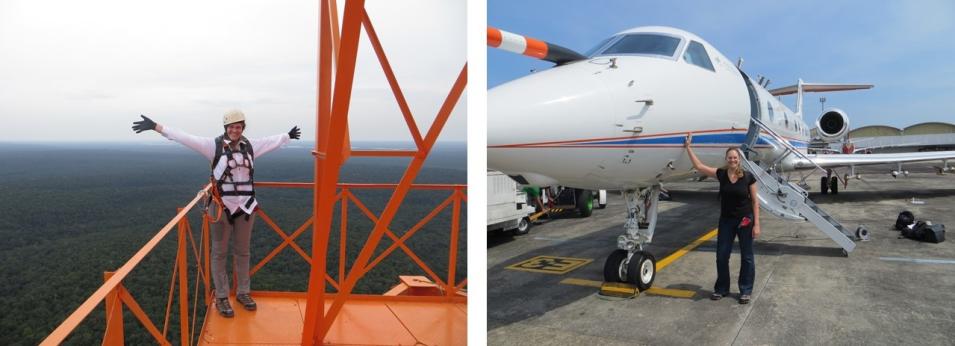The HALO aircraft soars even higher above the forest canopy. With its cruising altitude of more than 15 km (almost 50,000 ft.), a payload of up to three tons, and a range of more than 8,000 km (almost 5,000 miles), this unique German research aircraft facilitates continental-scale atmospheric measurements at altitudes as high as the lower stratosphere.
Albrecht points out that the Amazon is one of the few continental areas where it is still possible to observe atmospheric conditions during the wet season that resemble those that existed in pre-industrial times, especially in regard to aerosol concentrations. “Aerosol” is the term used to describe minute solid particles or liquid droplets that are suspended in air. Common aerosols include dust, water vapor, and smoke.
During the Amazon dry season, a majority of regional aerosols are from biomass burning. In addition, the city of Manaus in the heart of the Amazon is a source for aerosols from urban pollution throughout the year. These human-created aerosols serve as cloud condensation nuclei around which water vapor collects to form cloud droplets and, when large enough, rain and ice. The interaction of aerosols with cloud condensation nuclei and the impact of this on precipitation is referred to as Cloud-Aerosol-Precipitation Interactions (CAPI), which is a focus of Albrecht’s research.
Albrecht was part of a large multi-national campaign called the Aerosol, Cloud, Precipitation, and Radiation Interactions and Dynamics of Convective Cloud Systems (ACRIDICON), which used the HALO aircraft for atmospheric sampling across northern Brazil over Amazonia. ACRIDICON was conducted in conjunction with another campaign called Cloud processes of the main precipitation systems in Brazil: A contribution to cloud resolving modeling and the Global Precipitation Measurement (CHUVA) (chuva is the Portuguese word for rain). The CHUVA campaign collected data for the precise localization of intra-/inter-cloud and cloud-to-ground lightning in and around São Paulo and contributed data to the joint NASA/Japan Aerospace Exploration Agency Global Precipitation Measurement (GPM) mission (operational 2014-present). The goal of ACRIDICON-CHUVA was to quantify CAPI and thermodynamic, dynamic, and radiative effects of CAPI processes by combining field measurements with remotely-sensed satellite data.
One important finding from this campaign is that aerosols from urban pollution lead to a higher concentration of cloud condensation nuclei, which compete with water vapor to form cloud droplets. As a result, clouds in more polluted areas have a higher number of very small cloud droplets. The small size of these cloud droplets suppresses the process necessary for these small droplets to combine into large raindrops. This suppression, in turn, can result in no rain at all or it can give the cloud the extra time necessary to grow vertically to freezing temperatures and for the cloud droplets to freeze. As noted above, it is the collision of these frozen particles that leads to a separation of electrical charge in the cloud and the resulting lightning discharge.
Albrecht calls the Amazon a living laboratory for her studies of CAPI, cloud electrification, and lightning. As her research shows, certain areas have the right combination of ingredients to create hotspots for these powerful electrical displays—a fact the lightning-prone Roy Sullivan knew all too well.
Representative data products used:
Read about the research:
Braga, R.C., Rosenfeld, D., Weigel, R., Jurkat, T., Andreae, M.O., Wendisch, M., Pöschl, U., Voigt, C., Mahnke, C., Borrmann, S., Albrecht, R.I., Molleker, S., Vila, D.A., Machado, L.A.T. & Grulich, L. (2017). Aerosol concentrations determine the height of warm rain and ice initiation in convective clouds over the Amazon basin. Atmospheric Chemistry and Physics (in review). doi:10.5194/acp-2016-1155
Cecchini, M.A., Machado, L.A.T., Andreae, M.O., Martin, S.T., Albrecht, R.I., Artaxo, P., … Wendisch, M. (2017). Sensitivities of Amazonian clouds to aerosols and updraft speed. Atmospheric Chemistry and Physics, 17(16): 10037-10050. doi:10.5194/acp-2017-89
Albrecht, R.I., Goodman, S.J., Buechler, D.E., Blakeslee, R.J. & Christian, H.J. (2016). Where Are the Lightning Hotspots on Earth? Bulletin of the American Meteorological Society, 97(11): 2051–2068. doi:10.1175/bams-d-14-00193.1
Wendisch, M., Pöschl, U., Andreae, M.O., Machado, L.A.T., Albrecht, R., Schlager, H., … Afchine, A. (2016). ACRIDICON–CHUVA Campaign: Studying Tropical Deep Convective Clouds and Precipitation over Amazonia Using the New German Research Aircraft HALO. Bulletin of the American Meteorological Society, 97(10): 1885–1908. doi:10.1175/bams-d-14-00255.1
Machado, L.A.T., Silva Dias, M.A.F., Morales, C., Fisch, G., Vila, D., Albrecht, R., … Tokay, A. (2014). The Chuva Project: How Does Convection Vary across Brazil? Bulletin of the American Meteorological Society, 95(9): 1365–1380. doi:10.1175/bams-d-13-00084.1
Albrecht, R.I., Morales, C. A. & Silva Dias, M.A.F. (2011). Electrification of precipitating systems over the Amazon: Physical processes of thunderstorm development. Journal of Geophysical Research, 116(D8). doi:10.1029/2010jd014756
For more information
Explore more Data User Profiles

